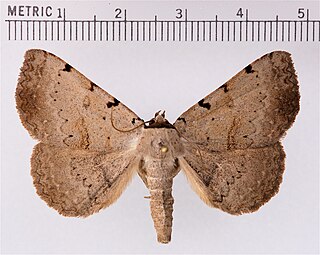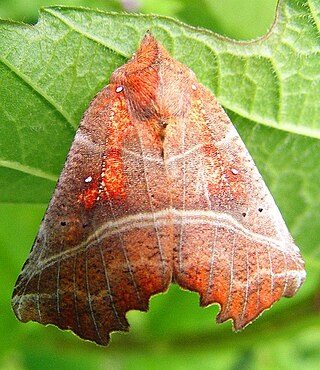
The Catocalini are a tribe of moths in the family Erebidae. Adults of many species in the tribe are called underwing moths due to their vividly colored hindwings that are often covered by contrastingly dark, drab forewings.

The Ophiusini are a tribe of moths in the family Erebidae.

The Phaegopterina are a subtribe of tiger moths in the tribe Arctiini, which is part of the family Erebidae. The subtribe was described by William Forsell Kirby in 1892. 469 species of Phaegopterina are present and 52 that are recently discovered in Brazil.

The Ctenuchina are a subtribe of moths in the family Erebidae.

The Herminiinae are a subfamily of moths in the family Erebidae. The members of the subfamily are called litter moths because the caterpillars of most members feed on dead leaves of plants, though others feed on living leaves, and/or the mushrooms of fungi as in the case of genus Idia.

The Aganainae are a small subfamily of moths in the family Erebidae. The adults and caterpillars of this subfamily are typically large and brightly colored, like the related tiger moths. Many of the caterpillars feed on poisonous host plants and acquire toxic cardenolides that make them unpleasant to predators. Like the closely related litter moths, the adults have long, upturned labial palps, and the caterpillars have fully or mostly developed prolegs on the abdomen. The Aganainae are distributed across the tropics and subtropics of the Old World.
Phlyctaina is a monotypic litter moth genus of the family Erebidae. Its only species, Phlyctaina irrigualis, is found in North America. Both the genus and species were first described by Heinrich Benno Möschler in 1890.

The Erebidae are a family of moths in the superfamily Noctuoidea. The family is among the largest families of moths by species count and contains a wide variety of well-known macromoth groups. The family includes the underwings (Catocala); litter moths (Herminiinae); tiger, lichen, and wasp moths (Arctiinae); tussock moths (Lymantriinae), including the arctic woolly bear moth ; piercing moths ; micronoctuoid moths (Micronoctuini); snout moths (Hypeninae); and zales, though many of these common names can also refer to moths outside the Erebidae. Some of the erebid moths are called owlets.

The Erebinae are a subfamily of moths in the family Erebidae erected by William Elford Leach in 1815. Erebine moths are found on all continents except Antarctica, but reach their greatest diversity in the tropics. While the exact number of species belonging to the Erebinae is not known, the subfamily is estimated to include around 10,000 species. Some well-known Erebinae include underwing moths (Catocala) and witch moths (Thermesiini). Many of the species in the subfamily have medium to large wingspans, up to nearly 30 cm in the white witch moth, which has the widest wingspan of all Lepidoptera. Erebine caterpillars feed on a broad range of plants; many species feed on grasses and legumes, and a few are pests of castor bean, sugarcane, rice, as well as pistachios and blackberries.

The Anobinae are a subfamily of moths in the family Erebidae described by Jeremy Daniel Holloway in 2005. Common morphological characteristics of Anobine moths include a dark head and prothoracic collar, lighter color on the thorax, and either bipectinate antennae or antennae with flagellomeral setae in males.

The Boletobiinae are a subfamily of moths in the family Erebidae, containing about 956 species. The taxon was described by Achille Guenée in 1858.

The Hypenodinae are a subfamily of moths in the family Erebidae. Adult moths of most species of this subfamily lack small, simple eyes near the large, compound eyes and have quadrifine (four-veined) hindwing cells. The micronoctuid moths are an exception because they possess simple eyes and bifine (two-veined) hindwing cells.

Eulepidotinae is a subfamily of moths in the family Erebidae. Adult males in the subfamily have midtibial tufts of hairs. Adult females have the ostial opening located between the seventh and eighth abdominal sternites instead of located anteriorly on the seventh sternite.

The Scoliopteryginae are a subfamily of moths in the family Erebidae. Larvae have distinctive, extra setae on the first through seventh abdominal segments. Many adult moths in the subfamily have a proboscis adapted to pierce fruit skin, allowing consumption of the juice in the fruit.

The Rivulinae are a subfamily of moths in the family Erebidae described by Augustus Radcliffe Grote in 1895. Caterpillars in the subfamily typically have long, barbed hairs and have full prolegs on abdominal segments 3 through 6. The adults have a unique microsculpturing proboscis.

The Scolecocampinae are a subfamily of moths in the family Erebidae. The taxon was erected by Augustus Radcliffe Grote in 1883.
The Toxocampinae are a subfamily of moths in the family Erebidae. Moths in the subfamily typically have a primitive form of genital claspers similar to those of some subfamilies of the Noctuidae.

The Melipotini are a tribe of moths in the family Erebidae.
The Omopterini are a tribe of moths in the family Erebidae.

The Poaphilini are a tribe of moths in the family Erebidae.

















